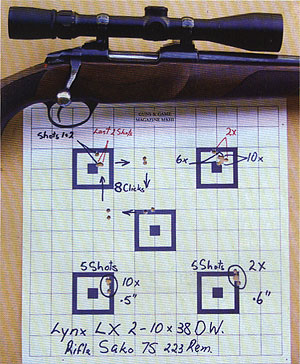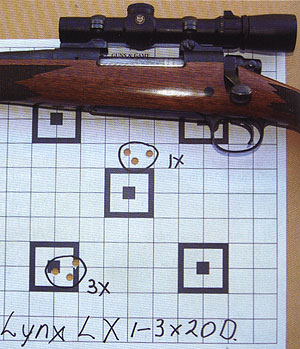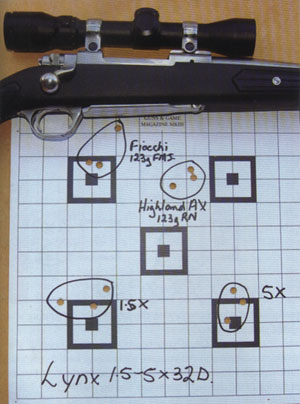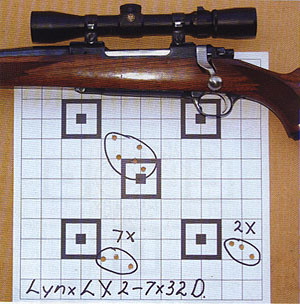
The new Lynx LX Series Scopes - By Andy Montgomary
It seems to be in the modern market place today and to have any chance of success your product must be bigger wider have more adjustment, have just that bit bigger range and do the most significant extra things over your competitors even if it actually detracts from your own products performance.
Take the Toyota Corolla when it first came out, it was a true small car that was simple and ultra reliable, now it is almost the size of a Kingswood and has more technology and do-dads whether it makes it better or not. Pretty near all consumer products are the same. Look at the humble phone, it now has almost as much computer powe3r as your PC, and it’s getting harder to get it to do what you brought it for, make a phone call. Sounds like grandpa (and I’m not one), doesn’t like change when it is a backward step, damn right! I had a friend turn up the other day with a Parker Hale .243 Winchester with a 6x24x40 on top and was he having some trouble. I showed him a 4x32 on one of my rifles and he wanted to swap straight away – buckleys!
 |
Lynx 2-10x38 DW test target with a 5-shot group shot at 10 power on the bottom left bull and a 5 shot group shot on 2 power on the bottom right hand bull. The round the target yielded amlost exactly the 2" for 8 clicks that it should have. it is great to see a scope with a 6mm (.25") click value instead of 10mm (.375") which I consider to be too much. I did adjust the scope before I did the power change test and I could have gone another click. It was great to see all 6 shots go into almost the one hole except the one shot on 2 power. |
Just when I thought all was lost in the world of modern rifle scope manufacturing Lynx has come along to save the day with 4 new models, three of which are about as close to perfect as it gets with slow focus lockable ocular lenses that are 38mm OD and so can be mounted as low as humanly possible. The fourth one has a fast focus non lockable ocular which measures 40.6mm.
The scopes are:
1) LX 1-3x20
2) LX 1.5-5x32D (Fast Focus)
3) LX 2-7x32D
4) LX 2-10x38D.
Why are these scopes such a plus for hunting, because they tick all the boxes for what we need (not dream you want) on a hunting rifle – they can be mounted very low; they are low powered enough to not require focusing apparatus. They are relatively light weight so when they are mounted on a rifle with a lot of recoil any standard mount will be capable of holding them still, (believe me heavy scopes are a problem when there is a lot of recoil). Because of their relatively small variable range they don’t run into light problems across their range. They have quite generous fields of view especially on the lower powers. Except for the 2-10x, all can be shot on any power without worrying about what power they are set on. Where if you have a 12, 16 or 24 power set wrong and a pig jumps out at your feet he is probably as safe as if you had no bullets, because if you can’t see him you can’t shoot him.
 |
Arguably the ultimate low mounted scope. The scope is a Lynx LX 1-3x20D set in Leupold bases and Leupold Super Low Rings, I did have to remove a small amount of metal from the back of the rear base to allow the scope to go forward enough for correct eye relief. This rifle scope combination is absolutely terrific to use as it shoulders like a fine shotgun and my eye is looking directly through the scope. This low mounting is not possible if the ocular is any bigger than the 38mm of this Lynx, as there is only about .75mm clearance for the bolt handle and the 700 Remington has one of the best shaped bolt handles in the business. On the power change test target there does appear to be a slight change in the point of impact, but when you factor in that reticle on 1 power covers approximately 3" at 100 yards the change becomes insignificant. This test was done at 100 yards asare all scopetests unless stated otherwise. |
Other changes on this new batch of Lynx scopes are the larger easily zeroed turrets which are easily adjusted in ¼” MOA increments. To zero the dials, you pull up on the adjustment ring which disconnects it with the adjustment spindle, zero the dial and press it down. It is also good to see a smaller click value as I find that 10mm 3/8” is too big, and even on a hunting rifle is too big an adjustment increment.
So what sort of rifles do I see these scopes fitting on? My all time favourite would be the 2-7x32 because it gives the most useful package with all the attributes I am always rabbiting on about. Let’s say a .223 Remington or .22-250 Remington, I can already hear the cries of not enough power. You are bound to take your .223 or .22-50 hunting other varmints, and what hunter would pass up a shot at a hog while shooting rabbits. So that 2-15 or 4-16 would fill the bill but not when you factor in using a bush rest and no bench rest these big scopes are suddenly handicapped back to 6 or 7 power because you can’t hold them still, and if it’s not hot (37 to 40 degrees C) you probably only need 3 or 4 power. Lets say a 6.5x55 or .270 Winchester or .300 Weatherby which you would conceivably hunt trophy game with which includes dear family and perhaps pigs. This 2-7x32 comes up a winner again as it is a small and light so the recoil of the .300 won’t be a worry, and because it can be mounted super low it is much less of a snag point on top of your rifle. On 7 power you can see enough to pick your trophy out of a group and with a good bush rest you will be able to place an accurate shot within the range of your rifle. I chose a Ruger LH .270 to test this scope as this rifle falls into your all round hunter category. With 90 grain Speer TNT, it is a formidable varminter and with 160 grain bullets it is a capable big game rifle.
The 2-10x38 I put on my Sako 75 varmint in .223 Remington mounted as low as I could get and it came up a treat.
The babies of the family, the 1-3x20 and 1.5-5x32 are probably more speciality scopes and would see service on close in pig rifles and big game rifles where your game is buffalo, wild cattle, and the calibre is perhaps .30-06 at the bottom of the scale to .375 / .416 / .458. I actually purchased a 1-3x20 before we were sent this batch to test and it is on my Remington LH CDL .30-06 and it works a treat because it gives enough power for those longer shots and on one power it is like a real open sight, only better because it has only one sighting plane. The other 1-3x20 we were sent for the test is mounted on a .375 Ruger Alaskan which is about perfect. On these bigger rifles the only warning is as it would be for any scope, make sure you mount it forward enough to avoid “Weatherby eyebrow”. The quoted eye relief is 93mm to 105mm, but measured is 73mm to 90mm from the back of the eye piece which is the bit that counts (go back to the article in G&G issue 36, “The right scope for your hunting rifle” for a detailed description of how to obtain this true measurement for eye relief).
This is plenty so long as you mount the scope forward so you have to reach just a bit and this will also help with recoil as you will have to pull the rifle into your shoulder, and that is a must with rifles that kick. The 1.5-5x32 I mounted on a Ruger 7.62x39 as this is arguably the ultimate ute rifle for the Aussie Shooter. This would hold true if this rifle was in .243 Winchester, 7mm-08 Remington or .308 Winchester.
 |
The power change test for the Lynx LX 1.5-5x32D which was mounted on a Ruger Model 77 MKII in 7.62x39. The different groups shot at the top of the target - the left hand group was shot with Fiocchi ammo and the right hand group was shot with Highland AX ammo. The bottom left hand goup was shot on 1.5 power and the right hand group was shot on 5 power and I would have to say there is no detectable difference. |
How did they all perform? Their biggest handicap was our lack of game – not even a humble hog could be found and as they are all dedicated hunting scopes the only one to receive the Guns and Game scope test was the 2-10x38 which was mounted on the Sako. It is a known performer and I was able to achieve a 5 shot group at 100 yards 0.5” on 10 power and 0.6” on 2 power. The power change test I would have to say would rival almost any scope we have tested regardless of style and make, with one shot on 2 power being the only fly in the ointment, but with a 6 shot group of 0.7” at 100 yards which comprised two shots fired on 2 power, 6 power and 10 power this makes for a pretty reliable hunting scope. I also conducted the power change test on the others in a slightly different way. I fired three shots on the highest power and three shots on the lowest power at different bullseyes, and I’m very pleased with the results as they show no detectable movement in point of impact which is great to see. This test became very difficult on the .30-06 as on one power the reticle covers about 75mm (3”), and so aim point definition on our Guns and Game targets was only possible using the whole target page as the aiming point. It appears as though I got a bit of movement from 3 power to 1 power, and there may well be, but if you have the scope set on 1x you are obviously expecting distances to be well under 100 yards, so the slight difference will be of no consequence.
It became very evident the more I used these scopes that regardless of the price / quality, if the manufacturers try to give too big a variable range, optical performance suffers in absolute clarity or the need to change to another lens that is focus to keep a good clear field of view. While this extra adjustment may not be a bother on a varmint / target scope it is in my opinion a major handicap on a hunting scope. Because I have always been a fixed power proponent I just plain forget to change the power when out hunting and that is one frustration I seem to get when mates come to go out hunting and they spend too much time fiddling with changing power and don’t concentrate on the job at hand of getting a well aimed shot away quickly.
 |
The favourite of the Lynx bunch the LX 2-7x32D on a left hand Ruger .270. The group above the middle bull was fired at the left hand bull as I forgot I had the rifle sighted in for a different load and while this group is nothing to skite about the rifle has been very reliable in the field. The bottom two groups are the ones that interest me, as yes there are slight differences, the combined 6 shots if they were superimposed over me another would be better than the 5 shot group at the top. |
In conclusion, if you’re hunting rifle is in need of a new scope I would recommend you take a good long look through these little variables from Lynx as they are, based on their performance at the top of the tree and I can assure you they will be staying there.
Lynx Optics scopes are imported by Lynx Optics: (02) 4981 7920.